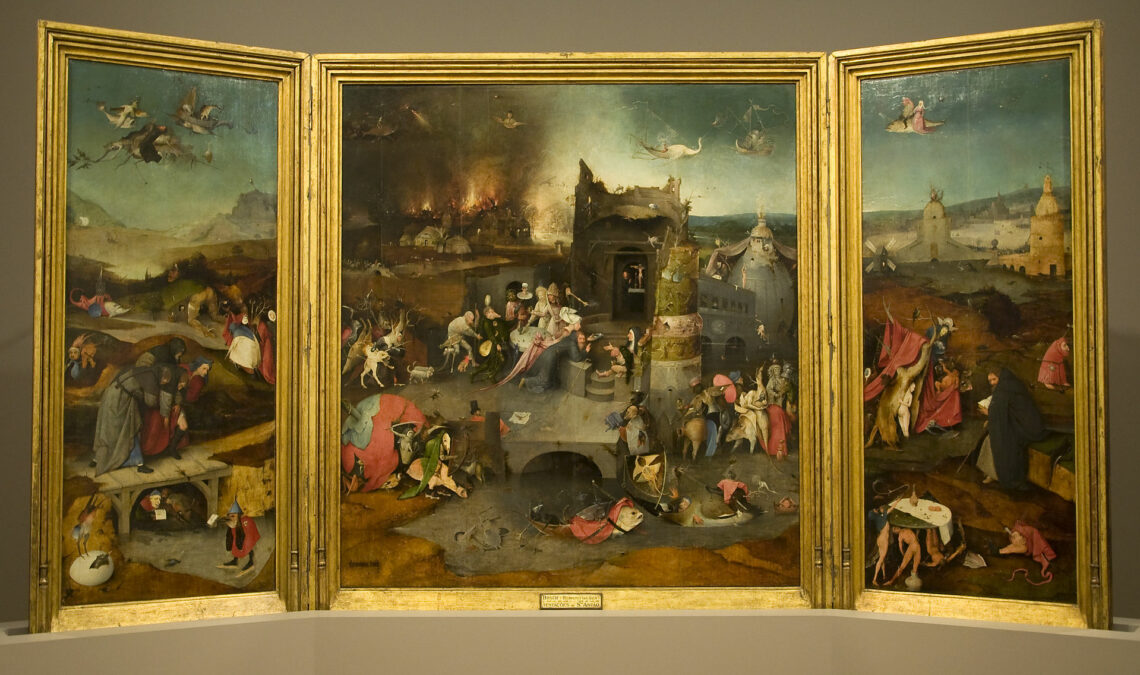Hieronymous Bosch’s Triptych of the Temptation of St. Anthony exemplifies his unique painting style that was characterized by rich symbolism and apocalyptic imagery depicting hell and unimaginable horrors. His grotesque, pessimistic, fantastic style had a far reaching influence on painters into the 20th century and greatly influenced the course of art history. In this article, Singulart takes a closer look at Bosch’s unique style and the symbolism of Triptych of the Temptation of St. Anthony.
Who was Hieronymous Bosch?

Hieronymous Bosch (c. 1450 – 1516) was a Dutch painter from Brabant and is one of the most renowned figures of Early Netherlandish painting. Not much is known about his life and education, thus his work is often divided by art historians into three periods: early, middle, and late. Most of his works were painted in oil on wood and he is most remembered for his triptychs which depict religious and allegorical scenes in his characteristically apocalyptic and grotesque style. It was Bosch’s unique style which had a great influence on Pieter Bruegel the Elder, the Dutch 16th century painter and also on the Surrealists in the 20th century. Bosch was considered the first modern artist by the Surrealists due to his daring departure from reality and his use of imagination to depict realms and imagery unknown to humankind. He is most famous for his detailed images of hell, which personify man’s greatest fears and the turmoil of inner emotional human life and are filled with absurd, grotesque imagery and metaphors.
What’s happening in Triptych of the Temptation of St. Anthony ?
The Temptation of Saint Anthony was a popular subject in Medieval and Renaissance art that Hieronymous Bosch painted as a triptych in oil on wood panels around 1501, during what is considered to be his late period. The story of Triptych of the Temptation of St. Anthony comes from the “Life of Saint Anthony” by Athanasius of Alexandria which was popular in Flanders at the time thanks to Pieter Van Os and Jacopo da Varazze. In his triptych, Bosch depicts the mental and spiritual torments of Saint Anthony the Great, one of the desert fathers of Egypt in the 4th century and was the perfect subject matter to exemplify Bosch’s fantastic, apocalyptic imagery.
Triptych of the Temptation of St. Anthony is made up of three wooden panels with two additional outer panels. The left panel depicts the Flight and Fall of Saint Anthony. In the sky, the saint is attacked by a group of demons. Below, carved into a hill shaped like a man on all fours is the saint’s grotto, towards which another group of demons, dressed as clergymen and a deer, march. In the foreground, Saint Anthony, who seems exhausted and unable to walk, is helped across the bridge by a monk and a layman, who is thought to also be a portrait of Bosch. The bridge crosses a lake, and underneath are huddled three figures reading a letter. On the lake, a bird-like demon skates and on the banks is another bird-demon on top of a hatching egg.

Left Panel 
Right Panel
The right panel depicts the Contemplation of Saint Anthony and here Bosch depicts Saint Anthony contemplating the naked body of a woman, who emerges from a tree trunk, held open for her by a toad. The nude female body was a symbol of luxury and the rest of the composition is filled with other diverse symbols personified by various demons, from the two figures flying on a fish to the group of demons in the foreground.

The central panel depicts the scene of The Temptation of Saint Anthony and is rife with apocalyptic, hellish imagery. In the center of the composition, on the steps of a crumbling tower kneels Saint Anthony, whose hand indicates to his small room where a miniature Christ on the Crucifix hangs. In the background, a city is on fire which was a traditional symbol of Saint Anthony’s power to protect against fire. The rest of the composition is taken up by groups of demons, in all shapes and sizes, exemplifying Bosch’s grotesque and imaginative style. The entire scene is fantastical and terrible and makes it easier to understand the debate regarding his intentions-whether he was motivated by heretical or orthodox religious views remains unclear.

On the other side of the panels are scenes depicting the Arrest of Christ and Christ Carrying the Cross painted in grisaille. The contrast between the interior scenes’ chaos and color and the exterior scenes subdued nature was common of the tradition for altarpieces, which would be closed during Lent. Thus it is the interior of Triptych of the Temptation of St. Anthony that reveals Bosch’s real talent and unique style.















